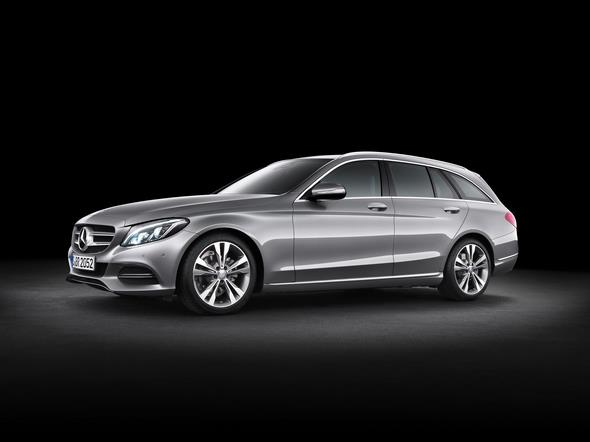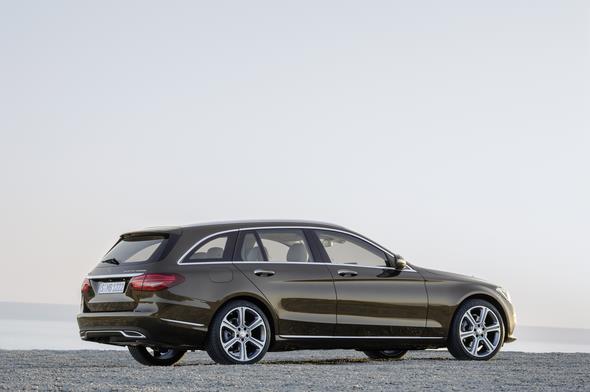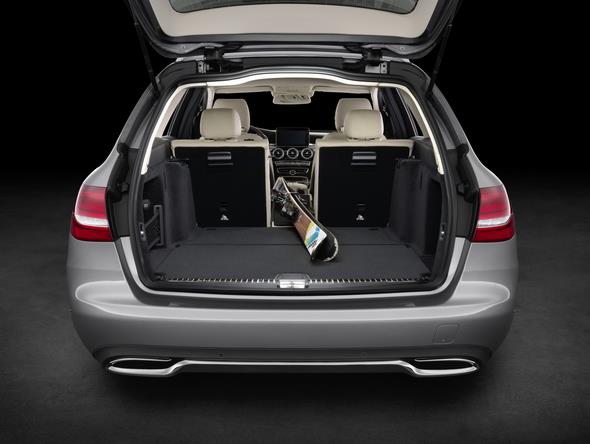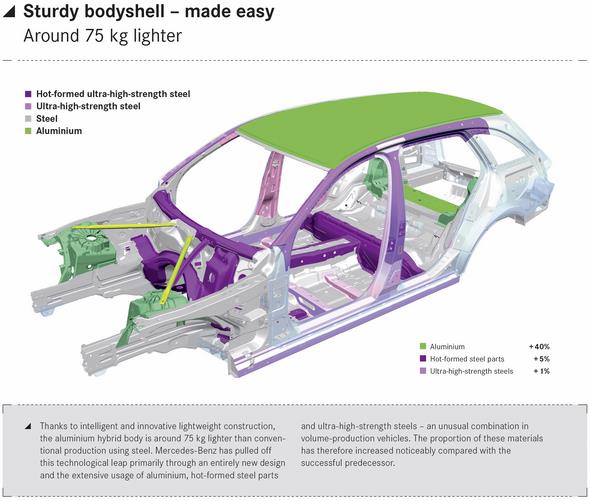The new Mercedes-Benz C-Class Estate

As multifaceted as modern life
Stuttgart – With the new Estate model Mercedes-Benz will expand the C-Class family starting in September 2014.
The Estate shines with a clear and at the same time emotional-sporty design, innovative technology, variability and a cargo volume enlarged even beyond that of the predecessor model.
Its high-class, sophisticated interior makes modern luxury tangible with design highlights. With these qualities the Estate reinforces its reputation as a multifaceted lifestyle vehicle with outstanding properties for everyday use.
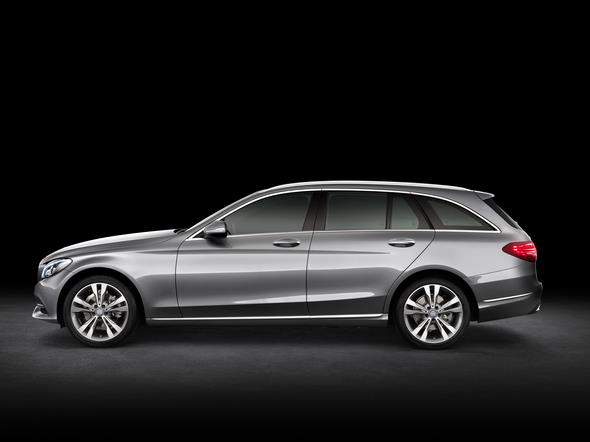
In addition, with its many new assistance systems it not only offers the highest standards of safety, but thanks to intelligent lightweight construction, exceptional aerodynamics and new economical engines it also sets new efficiency benchmarks in its segment.
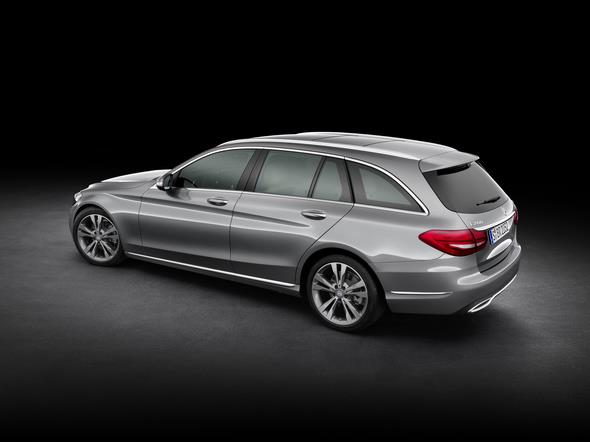
The Estate model also provides the stage for the world première of the Mercedes connect me services, which, among other things, make it possible to connect to the vehicle from anywhere at any time and retrieve the current fill level of the tank online.
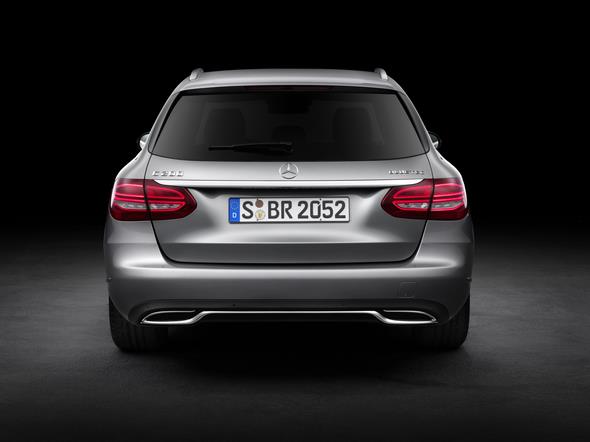
The new C-Class Estate combines a striking, dynamic design and high-class appointments with outstanding variability and a high level of utility.
With its versatility it also adapts to a wide variety of requirements. As a stylish, sporty space vehicle it accompanies active, modern people on shopping sprees, on vacation or when playing sports, and is suitable for families in every respect.
Consequently, it continues the tradition of the C-Class Estates, which all in their own time combined demands on lifestyle, sportiness and practicality in an estate car, in the fourth generation on a new level.
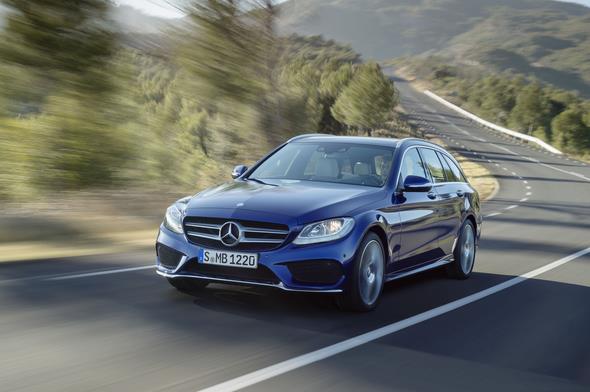
Prof Dr Thomas Weber, Member of the Board of Management of Daimler AG responsible for Group Research and Mercedes-Benz Cars Development: “The new C-Class Estate is not only extremely practical thanks to its large, variable load compartment.
With its state-of-the-art technical features it also strikes out in new directions in its segment with regard to safety, efficiency and comfort. And both men and women drivers enjoy noticeably more driving pleasure”.
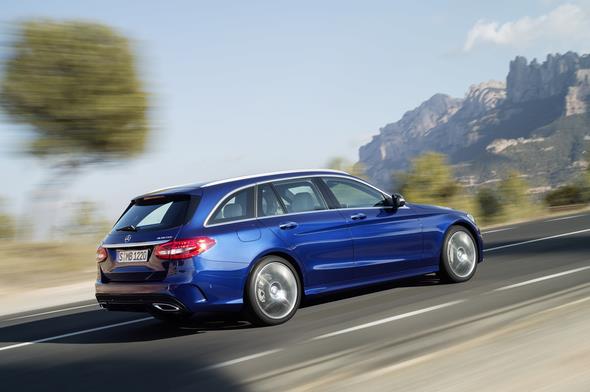
Variable and practical
The dimensions of new C-Class Estate have grown considerably.
With an 80millimetre increase in the wheelbase (2840 millimetres) compared with the previous model, the vehicle is 96 millimetres longer (4702 millimetres) and 40 millimetres wider (1810 millimetres).
The resulting increase in space primarily benefits the rear-seat passengers who now enjoy 45 millimetres more legroom. There is also more shoulder room, elbow room and headroom than in the previous model.
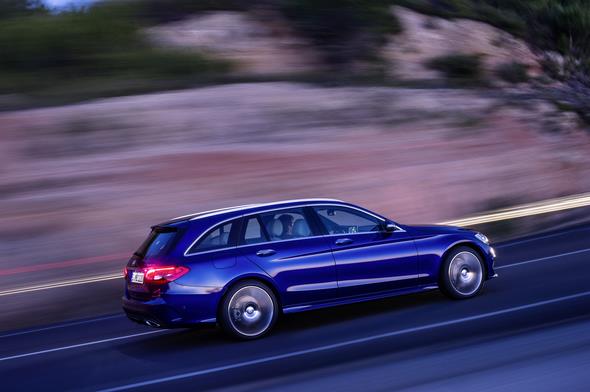
The moderate growth spurt also involves the load compartment. The sporty rear of the new C-Class Estate provides a maximum load capacity of 1510 litres (according to ISO 3832).
It thus surpasses its predecessor by ten litres. The load compartment volume behind the rear seats increased by five litres to 490 litres.

Variability and consequently functionality also increased significantly. The rear seats now have a 40 : 20 : 40 split instead of the 60 : 40 split in the predecessor.
This opens up a wide range of possibilities to use the interior as five-seater, four-seater, three-seater or two-seater.
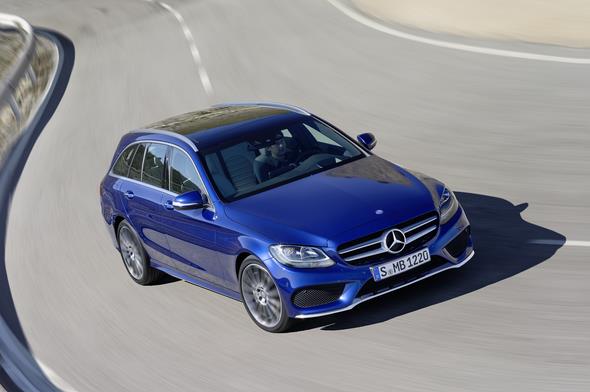
Practical details ensure that the load compartment is even more versatile and easier to use, and as a result it can be conveniently tailored to the individual transport tasks.
The rear-seat backrests can be unlocked and folded electrically at the push of a button to create a enlarged level load compartment.
The exceptional loading convenience can optionally be further enhanced with the EASY PACK power liftgate and the likewise optional HANDS-FREE ACCESS system.
It allows opening and closing the liftgate without touching it. All it takes is a motion of the foot in the area of the rear bumper.
Dynamic and of high value
The new C-Class sets visual highlights with a modern, dynamic design that at the same time exudes sensuous clarity, arouses emotions and, to top it all off, stages high-tech in perfect fashion.
Customers can choose from two fronts – with the sports grille or – reserved solely for the EXCLUSIVE Line – the luxury grille with the Mercedes star on the bonnet.
Unusual for a vehicle with a focus on a high level of utility and functionality is the high-value interior of the Estate, which was adopted from the Saloon.
With straightforward sportiness, thrilling flowing lines and high-grade materials on the level of a luxury vehicle, it realises a modern, luxurious and at the same time sporty ambience.
In addition to the base model, there are also three distinct design and equipment lines each for the exterior and interior.
The Estate also bears the quality seal of the European Centre for Allergy Research Foundation for a scientifically tested high level of allergy-friendliness. Mercedes-Benz is the only vehicle manufacturer to earn the ECARF seal.
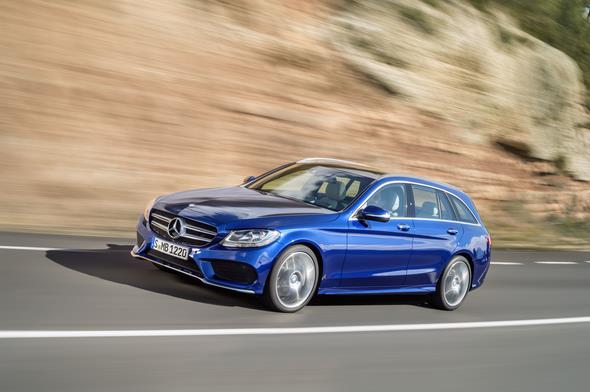
Touchpad and head-up display
The touchpad in the new C-Class Estate developed by Mercedes-Benz marks an evolutionary step. As on a smartphone, all the head-unit functions can be operated using finger gestures.
The 65 x 45 millimetre control surface of the touchpad is built into the handrest on the central control panel and bordered by a high-quality metal support – a design feature with a high-tech feel which exudes luxury at the same time.
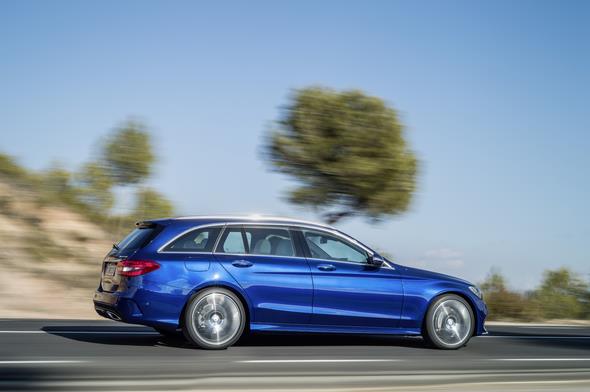
A head-up display is also new feature in the C-Class Estate. As in a jet fighter, it projects important information directly into the driver’s field of vision, ensuring that there is less distraction from the road ahead.
The system informs about vehicle speed, posted speed limits, navigation instructions and DISTRONIC messages.
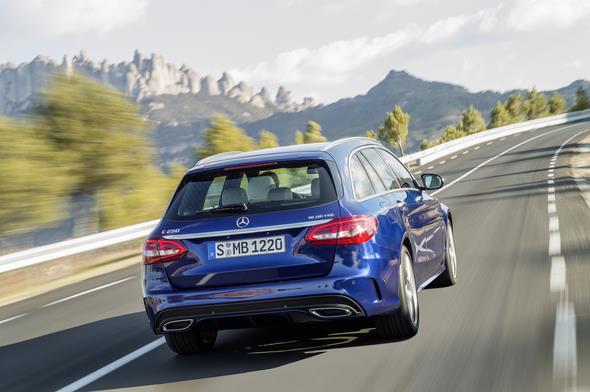
Less weight, more comfort
Thanks to innovative solutions, the body shell of the new C-Class Estate weighs less, provides the basis for outstanding vehicle handling and best noise and vibration comfort with exceptional rigidity, and offers a high level of crash safety.
With an aluminium content of 49 per cent and up to 65 kilograms less gross vehicle weight the Estate is the lightweight-construction leader in its segment.
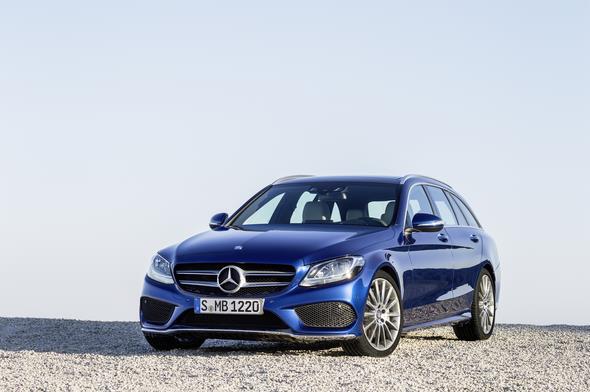
Efficient and lively engines
The powerful and efficient petrol and diesel engines with ECO start/stop function comply with Euro VI emissions standards and ensure sporty performance and driving pleasure.
Compared with the predecessor they in part consume in excess of 20 per cent less fuel.

The diesel models of the new C-Class are powered by the further advanced four-cylinder or the new small four-cylinder engine, which as BlueTEC models are all equipped with SCR technology (selective catalytic reduction).
They cover an output range from 85 kW (115 hp) to 150 kW (204 hp).
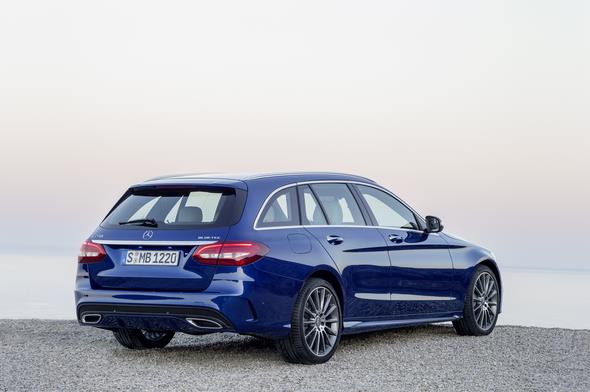
In addition, Mercedes-Benz offers a diesel engine combined with a hybrid module. The C 300 BlueTEC HYBRID with four-cylinder diesel engine and compact electric motor generates a power output of 150 + 20 kW (204 + 27 hp) and despite its high power output runs on just 3.8 litres of diesel per 100 km/h in NEDC combined mode (equivalent to 99 grams of CO2 per kilometre).
Three BlueDIRECT four-cylinder petrol engines and one BlueDIRECT sixcylinder petrol engine with power outputs ranging from 115 to 245 kW (156 to 333 hp) will initially be available for the new C-Class.
The four-cylinder C 350 HYBRID with plug-in technology and a power output of 155 + 50 kW will follow in due course.
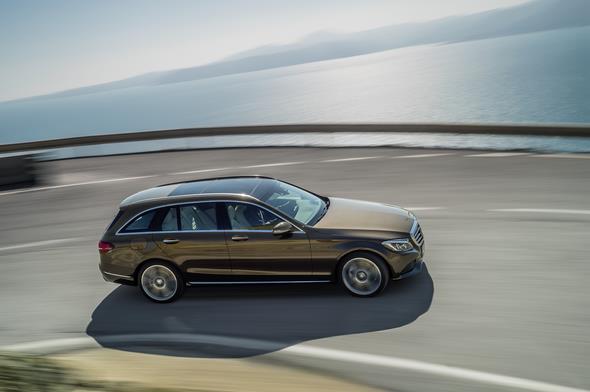
Agile and comfortable driving
Exemplary ride comfort coupled with outstanding dynamic vehicle handling – these are the hallmarks of the newly designed suspension of the new C-Class Estate.
Thanks to a new four-link front axle it offers driving pleasure and ride comfort at the same time.
C-Class Estate customers will have a choice of two versions of the standard-specification steel suspension, which also includes a sporty set-up. As an alternative, Mercedes-Benz for the first time offers an air suspension in this segment.
The AIRMATIC air suspension manages to bridge the gap between a high level of ride comfort and dynamic-agile handling. AIRMATIC also features all-round self-levelling for optimum ride comfort even with the vehicle loaded.
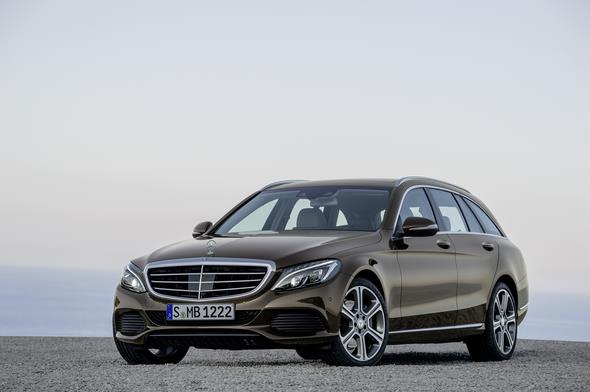
Choose your own driving experience
In the new C-Class Estate the driver can determine the desired driving programme at the push of a button. Depending on the equipment level, the driver can choose from various preconfigured drive programmes and one the driver can design personally to a large extent.
The following characteristics are available: “Comfort”, “ECO”, “Sport” and “Sport+”. The additional “Individual” option enables drivers to configure their vehicle to suit their own preferences.
Like the Saloon, the new C-Class Estate is equipped with an electric parking brake. This brake is released automatically when the driver ends parking mode with the aim of moving off.
As is customary, the new C-Class is also available with 4MATIC all-wheel drive.
Steering with a sporty character
All models of the C-Class family will in future feature the electromechanical Direct-Steer system as standard. It combines road-speed dependent power assistance from the speed-sensitive power steering system, with a steering ratio that varies according to the given steering angle.
The power steering assist provided by the rack-and-pinion steering gear is controlled as needed, thereby contributing towards efficiency.
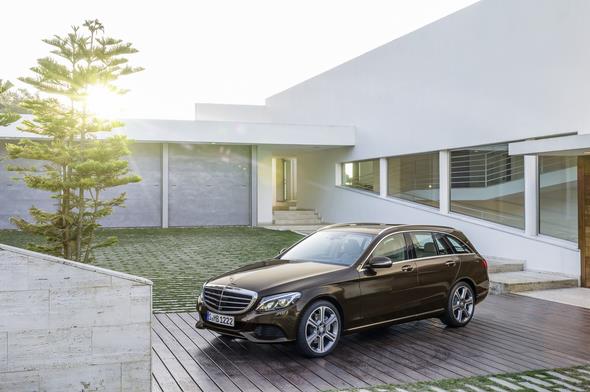
Mercedes-Benz Intelligent Drive: the intelligent car
It is the declared aim of Mercedes-Benz to make the highest standard of safety available to everyone. For this reason the Estate adopts almost all new assistance systems from the S- and E-Class, which have been enhanced with significant functions. The assistance systems increase both comfort and safety. Mercedes-Benz calls this Intelligent Drive.
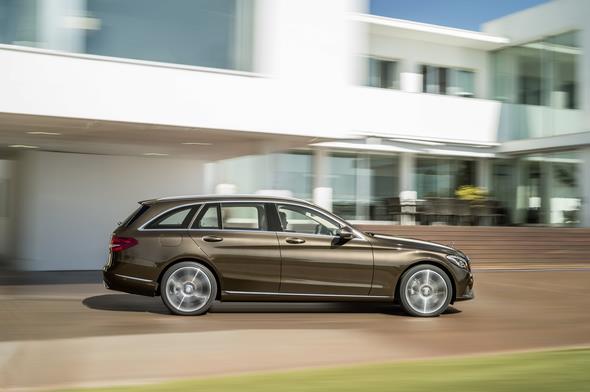
The C-Class Estate is fitted as standard with ATTENTION ASSIST, which can warn the driver of inattentiveness and drowsiness.
It offers an adjustable sensitivity level and can provide drivers with information on their level of fatigue and the amount of driving time that has elapsed since the last break.
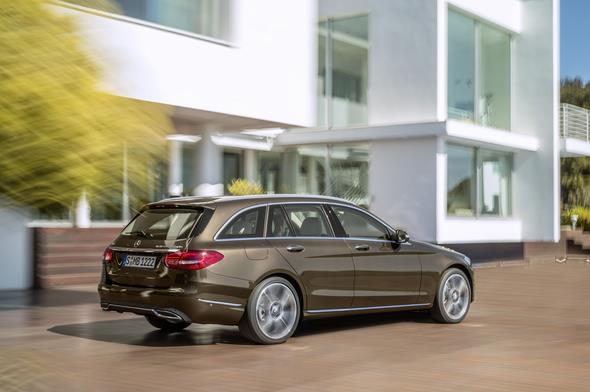
Also part of the standard equipment is COLLISION PREVENTION ASSIST PLUS.
In addition to the adaptive Brake Assist system, which helps to protect against collisions at speeds above 7 km/h, this system now features an additional function: when a danger of collision persists and the driver fails to respond, the system is able to carry out autonomous braking at speeds of up to 105 km/h (200 km/h in conjunction with DISTRONIC PLUS), thereby reducing the severity of collisions with slower or stopping vehicles.
The system also brakes in response to stationary vehicles at a speed of up to 50 km/h, and is able to prevent rear-end collisions at up to 40 km/h.

New assistance systems with enhanced functions are optionally available, combining data from various sensor technologies as part of the Intelligent Drive concept to enhance comfort and safety:
- DISTRONIC PLUS – relieves the burden on the driver in keeping a safe following distance
- DISTRONIC PLUS with Steering Assist and Stop&Go Pilot relieves
the burden on the driver in keeping a safe following distance, even in stop & go traffic. Steering Assist is new and helps the driver with lateral control of the vehicle, even in gentle bends, and offers a tailback vehicle following function.
- BAS PLUS with Cross-Traffic Assist boosts driver braking depending on the situation, if necessary up to full brake application and, for the first time, can also react to crossing traffic and pedestrians.
- Active Lane Keeping Assist warns of unintentional lane departures by means of pulsed vibrations of the steering wheel and in the presence of solid lane markings corrects the vehicle’s track with one-sided brake application. It now also intervenes with one-sided brake applications in the presence of broken lane markings if the adjacent lane is occupied by, for example, oncoming traffic, fast overtaking or overtaken vehicles.
The multitude of optionally available assistance systems also include, among others
- Active Parking Assist, which enables automated parking with active steering and brake intervention in both parallel and end-on parking spaces
- Traffic Sign Assist with wrong-way warning function, which warns of speed limits and also alerts the driver to no-overtaking zones and noentry signs
- Adaptive Highbeam Assist Plus, which allows the high-beam headlamps to be kept on permanently by masking out other vehicles
in the light cone of the high-beam headlamps
Airbags for safety
In addition to 3-point safety belts with pyrotechnical belt tensioning and belt-force limitation for driver, front passenger and those in the outer rear seats, numerous airbags serve to protect the vehicle’s occupants in an accident. These include:
- combined thorax/pelvis sidebags for driver and front passenger
- an optimised windowbag
- sidebags for the outer rear seats (optional)
- a kneebag for the driver
The front-passenger’s seat can furthermore be equipped with an automatic child seat recognition system.
This automatic front-passenger’s airbag deactivation, introduced first by Mercedes-Benz, uses a pressure sensor in the seat cushion to detect whether an infant or child seat was placed on the front-passenger’s seat and automatically deactivates the front-passenger’s airbag.
Contrary to other systems that require the airbag to be deactivated with a key, this system prevents incorrect operation. As no special transponder is required, the system works with all rear-facing child restraint systems.
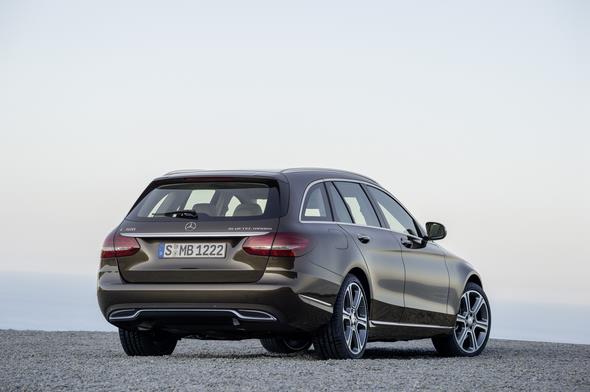
Climate control: signals from space
The further advanced climate control system provides improved control quality, performance, efficiency and air quality. The new Estate is the only vehicle in the segment to offer tunnel detection via satellite navigation.
It uses the map data from the navigation system and the GPS location data to close the air recirculation flap automatically when the vehicle enters a tunnel, subsequently re-opening it when the vehicle emerges from the tunnel.
Another highlight contributing to a feel-good atmosphere is the AIR BALANCE package with active fragrancing, air ionisation and more efficient filtration than is available on the standard model.
Vibrant infotainment experience
Like the Saloon, the new Estate offers a completely new multimedia generation with intuitive operation, featuring elaborate animations and visual effects which present all the functions in a clear and highly attractive manner.
The Estate is furthermore also equipped with the Frontbass system. This avant-garde acoustic systems uses the space within the cross-member and side member in the body structure as a resonance chamber for the subwoofers.
The result is a listening experience almost on a par with that enjoyed in a concert hall. A Burmester® surround sound system is optionally available.
The navigation system presents its contents in interactive mode. Its features include an animated compass, a “Drive Show” with information for passengers similar to the on-screen presentations on board airliners and Google Maps displayed on the head unit.
COMAND Online is now also able to provide more accurate real-time information about the situation on the roads when it receives its traffic data via the internet by means of the “Live Traffic Information” service.
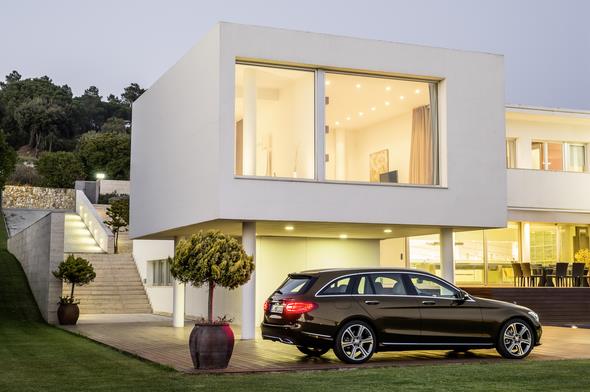
Internet and diverse data sources
A Bluetooth-compatible mobile phone with data option is all it takes to make even the Audio 20 system internet-capable. This enables the internet to be surfed without restrictions when the vehicle is stationary.
In conjunction with COMAND Online, Mercedes-Benz Apps such as Weather, GoogleTM Local Search with StreetView and Panoramio, destination/route download and Facebook can be used while on the move.
Audio and video playback is possible from various sources. For example, via Bluetooth®, from an Apple iPod® or iPhone®, from an SD card, USB stick or CD/DVD (with Audio 20 CD or higher and with COMAND Online).
COMAND Online with hotspot functionality
COMAND Online not only offers a larger display with a resolution of 960 x 540 pixels and a special bonded glass cover such as is familiar from consumer devices like the iPhone® or iPad.

It also enables digital TV/radio reception, for example, and offers fast hard-disc navigation, automatic tailback avoidance via up-to-date and accurate “Live Traffic Information”, an integrated WLAN hotspot functionality and the LINGUATRONIC voice-operated control system.
Telephony via Bluetooth® as standard
The standard Audio 20 USB system as well as Audio 20 CD and COMAND Online all offer basic telephony as standard, which links up a mobile phone to the vehicle via a standardised Bluetooth® interface.
Vehicle online with Mercedes connect me
Mercedes-Benz will introduce a new package of services in Europe under the name “Mercedes connect me” with the new C-Class Estate.
The “Mercedes connect me” services can be used via a KOM module with its own SIM card integrated into the vehicle. The available services include accident, maintenance and breakdown management, for example.
Likewise, customers can connect to their vehicle from anywhere and at any time via “Mercedes connect me“ and, among other things, retrieve the fill level of the tank or start, stop or programme the auxiliary heating system.
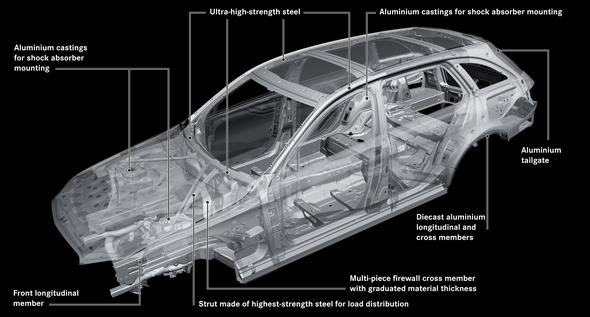
The new Mercedes-Benz C-Class Estate
As multifaceted as modern life
Bremen / Stuttgart – With the new Estate model Mercedes-Benz will expand the CClass family starting in September 2014.
The Estate shines with a clear and at the same time emotional-sporty design, innovative technology, variability and a cargo volume enlarged even beyond that of the predecessor model.
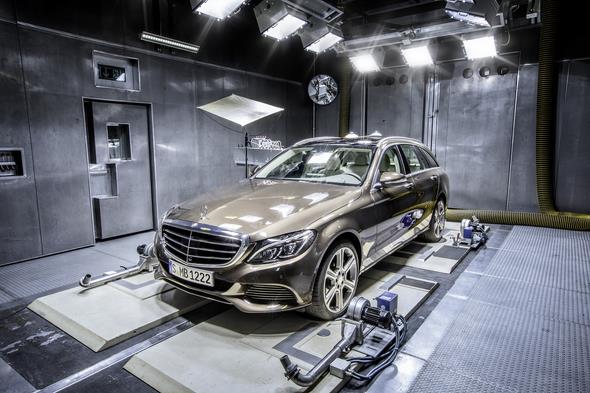
Its high-class, sophisticated interior makes modern luxury tangible with design highlights.
With these qualities the Estate reinforces its reputation as a multifaceted lifestyle vehicle with outstanding properties for everyday use.
In addition, with its many new assistance systems it not only offers the highest standards of safety, but thanks to intelligent lightweight construction, exceptional aerodynamics and new economical engines it also sets new efficiency benchmarks in its segment.
The Estate model also provides the stage for the world première of the Mercedes connect me services, which, among other things, make it possible to connect to the vehicle from anywhere at any time and retrieve the current fill level of the tank online.
The new C-Class Estate combines a striking, dynamic design and high-class appointments with outstanding variability and a high level of utility.
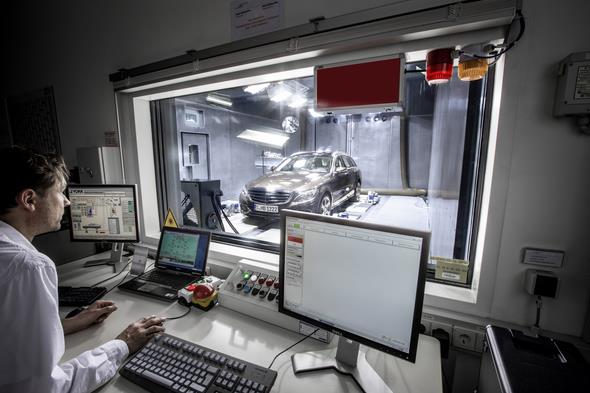
With its versatility it also adapts to a wide variety of requirements. As a stylish, sporty space vehicle it accompanies active, modern people on shopping sprees, on vacation or when playing sports, and is suitable for families in every respect.
Consequently, it continues the tradition of the C-Class Estates, which all in their own time combined demands on lifestyle, sportiness and practicality in an estate car, in the fourth generation on a new level.
Prof.Dr Thomas Weber, Member of the Board of Management of Daimler AG responsible for Group Research and Mercedes-Benz Cars Development: “The new C-Class Estate is not only extremely practical thanks to its large, variable load compartment.
With its state-of-the-art technical features it also strikes out in new directions in its segment with regard to safety, efficiency and comfort. And both men and women drivers enjoy noticeably more driving pleasure”.
Variable and practical
The dimensions of new C-Class Estate have grown considerably. With an 80millimetre increase in the wheelbase (2840 millimetres) compared with the previous model, the vehicle is 96 millimetres longer (4702 millimetres) and 40 millimetres wider (1810 millimetres).
The resulting increase in space primarily benefits the rear-seat passengers who now enjoy 45 millimetres more legroom. There is also more shoulder room, elbow room and headroom than in the previous model.

The moderate growth spurt also involves the load compartment. The sporty rear of the new C-Class Estate provides a maximum load capacity of 1510 litres (according to ISO 3832).
It thus surpasses its predecessor by ten litres. The load compartment volume behind the rear seats increased by five litres to 490 litres.
Variability and consequently functionality also increased significantly. The rear seats now have a 40 : 20 : 40 split instead of the 60 : 40 split in the predecessor. This opens up a wide range of possibilities to use the interior as five-seater, four-seater, three-seater or two-seater.
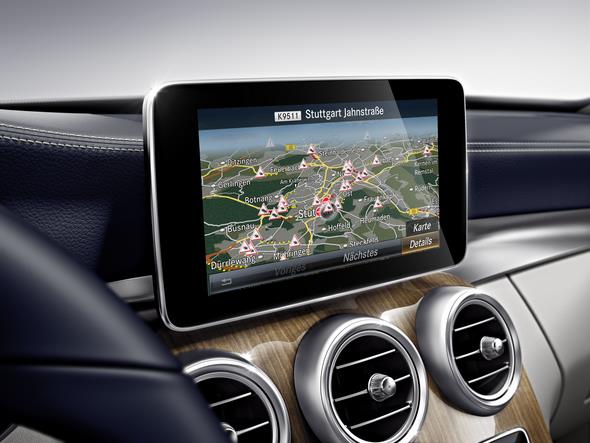
Practical details ensure that the load compartment is even more versatile and easier to use, and as a result it can be conveniently tailored to the individual transport tasks. The rear-seat backrests can be unlocked and folded electrically at the push of a button to create a enlarged level load compartment.
The exceptional loading convenience can optionally be further enhanced with the EASY PACK power liftgate and the likewise optional HANDS-FREE ACCESS system. It allows opening and closing the liftgate without touching it. All it takes is a motion of the foot in the area of the rear bumper.
Dynamic and of high value
The new C-Class sets visual highlights with a modern, dynamic design that at the same time exudes sensuous clarity, arouses emotions and, to top it all off, stages high-tech in perfect fashion.
Customers can choose from two fronts – with the sports grille or – reserved solely for the EXCLUSIVE Line – the luxury grille with the Mercedes star on the bonnet.
Unusual for a vehicle with a focus on a high level of utility and functionality is the high-value interior of the Estate, which was adopted from the Saloon.
With straightforward sportiness, thrilling flowing lines and high-grade materials on the level of a luxury vehicle, it realises a modern, luxurious and at the same time sporty ambience. In addition to the base model, there are also three distinct design and equipment lines each for the exterior and interior.
The Estate also bears the quality seal of the European Centre for Allergy Research Foundation for a scientifically tested high level of allergy-friendliness. Mercedes-Benz is the only vehicle manufacturer to earn
the ECARF seal.
Touchpad and head-up display
The touchpad in the new C-Class Estate developed by Mercedes-Benz marks an evolutionary step. As on a smartphone, all the head-unit functions can be operated using finger gestures.
The 65 x 45 millimetre control surface of the touchpad is built into the handrest on the central control panel and bordered by a high-quality metal support – a design feature with a high-tech feel which exudes luxury at the same time.
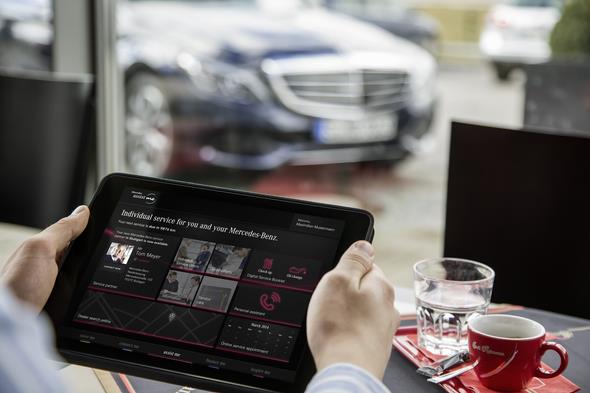
A head-up display is also new feature in the C-Class Estate. As in a jet fighter, it projects important information directly into the driver’s field of vision, ensuring that there is less distraction from the road ahead.
The system informs about vehicle speed, posted speed limits, navigation instructions and DISTRONIC messages.
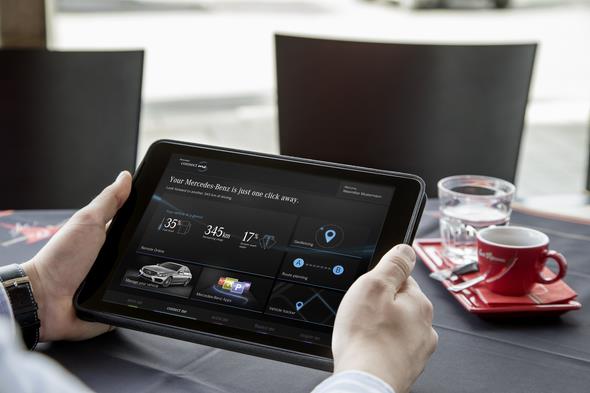
Less weight, more comfort
Thanks to innovative solutions, the body shell of the new C-Class Estate weighs less, provides the basis for outstanding vehicle handling and best noise and vibration comfort with exceptional rigidity, and offers a high level of crash safety.
With an aluminium content of 49 per cent and up to 65 kilograms less gross vehicle weight the Estate is the lightweight-construction leader in its segment.
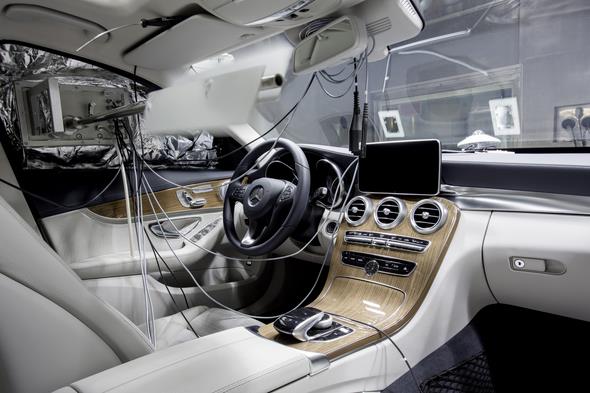
Efficient and lively engines
The powerful and efficient petrol and diesel engines with ECO start/stop function comply with Euro VI emissions standards and ensure sporty performance and driving pleasure.
Compared with the predecessor they in part consume in excess of 20 per cent less fuel.
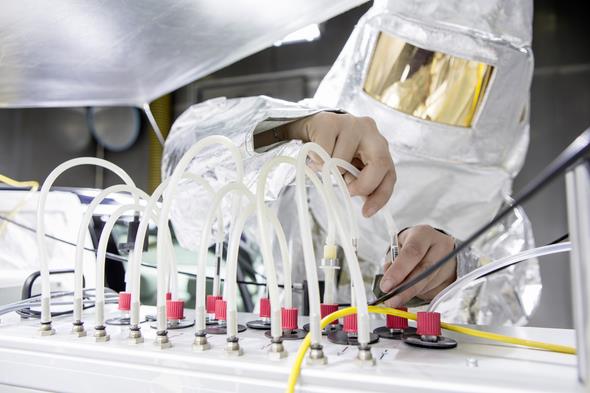
The diesel models of the new C-Class are powered by the further advanced four-cylinder or the new small four-cylinder engine, which as BlueTEC models are all equipped with SCR technology (selective catalytic reduction). They cover an output range from 85 kW (115 hp) to 150 kW (204 hp).
In addition, Mercedes-Benz offers a diesel engine combined with a hybrid module. The C 300 BlueTEC HYBRID with four-cylinder diesel engine and compact electric motor generates a power output of 150 + 20 kW (204 + 27 hp) and despite its high power output runs on just 3.8 litres of diesel per 100 km/h in NEDC combined mode (equivalent to 99 grams of CO2 per kilometre).
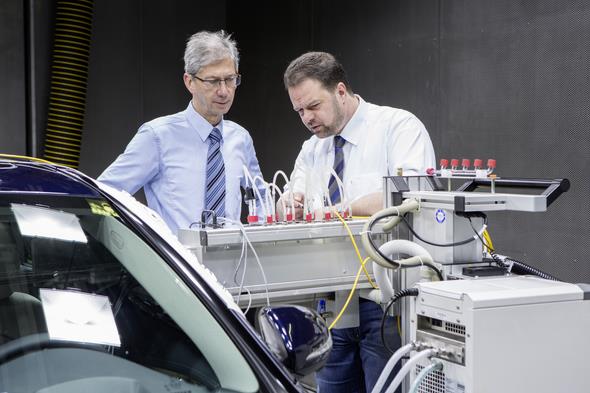
Three BlueDIRECT four-cylinder petrol engines and one BlueDIRECT sixcylinder petrol engine with power outputs ranging from 115 to 245 kW (156 to 333 hp) will initially be available for the new C-Class.
The four-cylinder C 350 HYBRID with plug-in technology and a power output of 155 + 50 kW will follow in due course.

Agile and comfortable driving
Exemplary ride comfort coupled with outstanding dynamic vehicle handling – these are the hallmarks of the newly designed suspension of the new C-Class Estate. Thanks to a new four-link front axle it offers driving pleasure and ride comfort at the same time.
C-Class Estate customers will have a choice of two versions of the standard-specification steel suspension, which also includes a sporty set-up.
As an alternative, Mercedes-Benz for the first time offers an air suspension in this segment. The AIRMATIC air suspension manages to bridge the gap between a high level of ride comfort and dynamic-agile handling.
AIRMATIC also features all-round self-levelling for optimum ride comfort even with the vehicle loaded.
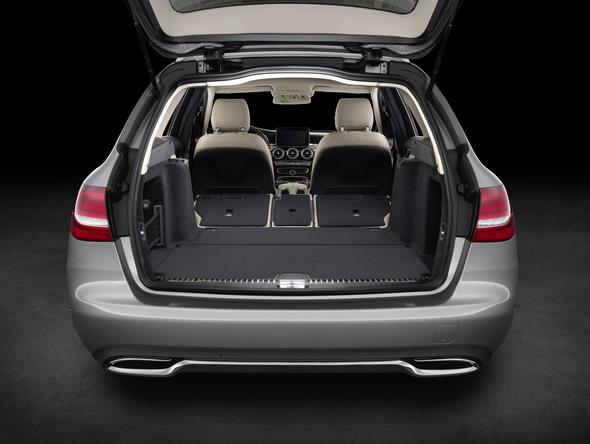
Choose your own driving experience
In the new C-Class Estate the driver can determine the desired driving programme at the push of a button. Depending on the equipment level, the driver can choose from various preconfigured drive programmes and one the driver can design personally to a large extent.
The following characteristics are available: “Comfort”, “ECO”, “Sport” and “Sport+”. The additional “Individual” option enables drivers to configure their vehicle to suit their own preferences.
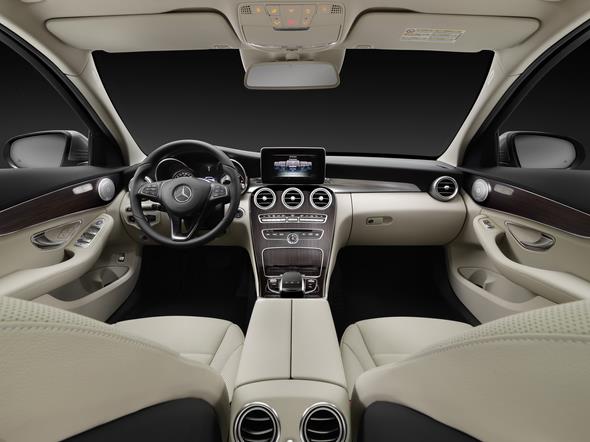
Like the Saloon, the new C-Class Estate is equipped with an electric parking brake. This brake is released automatically when the driver ends parking mode with the aim of moving off.
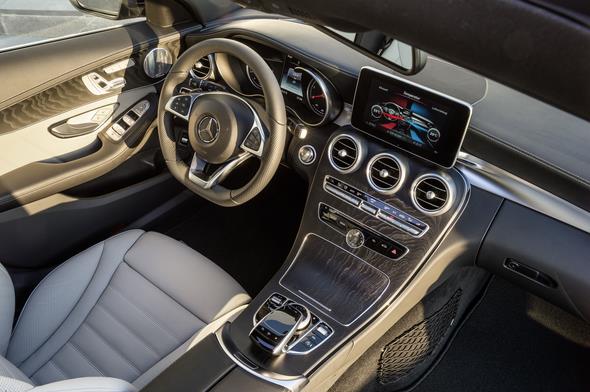
As is customary, the new C-Class is also available with 4MATIC all-wheel drive.
Steering with a sporty character
All models of the C-Class family will in future feature the electromechanical Direct-Steer system as standard. It combines road-speed dependent power assistance from the speed-sensitive power steering system, with a steering ratio that varies according to the given steering angle.
The power steering assist provided by the rack-and-pinion steering gear is controlled as needed, thereby contributing towards efficiency.
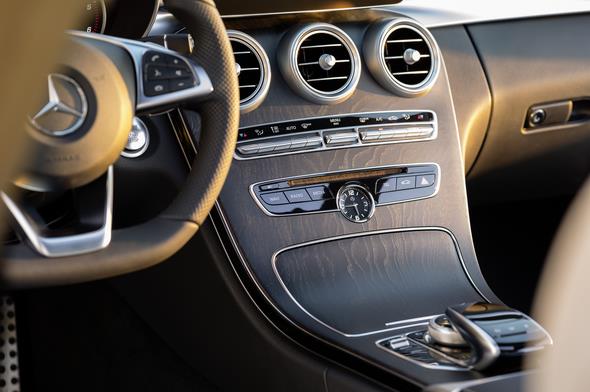
Mercedes-Benz Intelligent Drive: the intelligent car
It is the declared aim of Mercedes-Benz to make the highest standard of safety available to everyone. For this reason the Estate adopts almost all new assistance systems from the S- and E-Class, which have been enhanced with significant functions.
The assistance systems increase both comfort and safety. Mercedes-Benz calls this Intelligent Drive.
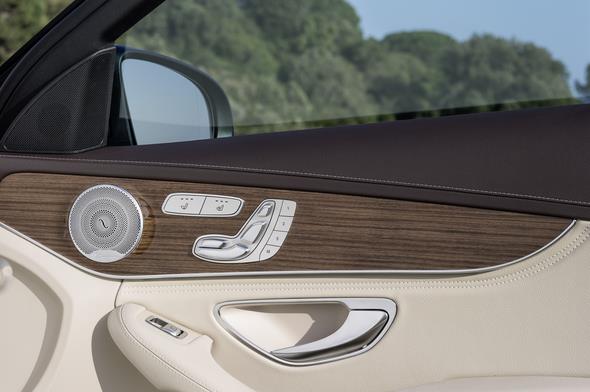
The C-Class Estate is fitted as standard with ATTENTION ASSIST, which can warn the driver of inattentiveness and drowsiness.
It offers an adjustable sensitivity level and can provide drivers with information on their level of fatigue and the amount of driving time that has elapsed since the last break.
Also part of the standard equipment is COLLISION PREVENTION ASSIST PLUS.
In addition to the adaptive Brake Assist system, which helps to protect against collisions at speeds above 7 km/h, this system now features an additional function: when a danger of collision persists and the driver fails to respond, the system is able to carry out autonomous braking at speeds of up to 105 km/h (200 km/h in conjunction with DISTRONIC PLUS), thereby reducing the severity of collisions with slower or stopping vehicles.
The system also brakes in response to stationary vehicles at a speed of up to 50 km/h, and is able to prevent rear-end collisions at up to 40 km/h.
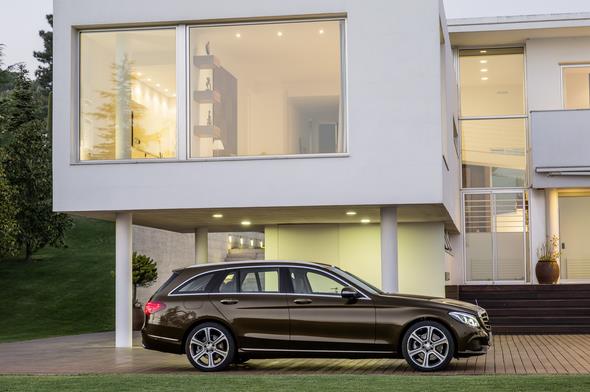
New assistance systems with enhanced functions are optionally available, combining data from various sensor technologies as part of the Intelligent Drive concept to enhance comfort and safety:
- DISTRONIC PLUS – relieves the burden on the driver in keeping a safe following distance
- DISTRONIC PLUS with Steering Assist and Stop&Go Pilot relieves
the burden on the driver in keeping a safe following distance, even in stop & go traffic. Steering Assist is new and helps the driver with lateral control of the vehicle, even in gentle bends, and offers a tailback vehicle following function.
- BAS PLUS with Cross-Traffic Assist boosts driver braking depending on the situation, if necessary up to full brake application and, for the first time, can also react to crossing traffic and pedestrians.
- Active Lane Keeping Assist warns of unintentional lane departures by means of pulsed vibrations of the steering wheel and in the presence of solid lane markings corrects the vehicle’s track with one-sided brake application. It now also intervenes with one-sided brake applications in the presence of broken lane markings if the adjacent lane is occupied by, for example, oncoming traffic, fast overtaking or overtaken vehicles.

The multitude of optionally available assistance systems also include, among others
- Active Parking Assist, which enables automated parking with active steering and brake intervention in both parallel and end-on parking spaces
- Traffic Sign Assist with wrong-way warning function, which warns of speed limits and also alerts the driver to no-overtaking zones and no-entry signs
- Adaptive Highbeam Assist PLUS, which allows the high-beam headlamps to be kept on permanently by masking out other vehicles
in the light cone of the high-beam headlamps
Airbags for safety
In addition to 3-point safety belts with pyrotechnical belt tensioning and belt-force limitation for driver, front passenger and those in the outer rear seats, numerous airbags serve to protect the vehicle’s occupants in an accident. These include:
- combined thorax/pelvis sidebags for driver and front passenger
- an optimised windowbag
- sidebags for the outer rear seats (optional)
- a kneebag for the driver
The front-passenger’s seat can furthermore be equipped with an automatic child seat recognition system. This automatic front-passenger’s airbag deactivation, introduced first by Mercedes-Benz, uses a pressure sensor in the seat cushion to detect whether an infant or child seat was placed on the front-passenger’s seat and automatically deactivates the front-passenger’s airbag.
Contrary to other systems that require the airbag to be deactivated with a key, this system prevents incorrect operation. As no special transponder is required, the system works with all rear-facing child restraint systems.
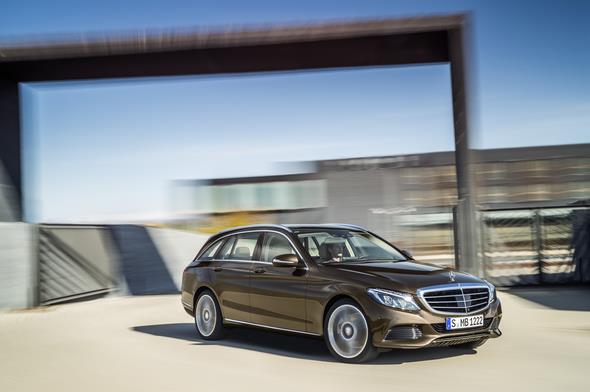
Climate control: signals from space
The further advanced climate control system provides improved control quality, performance, efficiency and air quality. The new Estate is the only vehicle in the segment to offer tunnel detection via satellite navigation.
It uses the map data from the navigation system and the GPS location data to close the air recirculation flap automatically when the vehicle enters a tunnel, subsequently re-opening it when the vehicle emerges from the tunnel.
Another highlight contributing to a feel-good atmosphere is the AIR BALANCE package with active fragrancing, air ionisation and more efficient filtration than is available on the standard model.
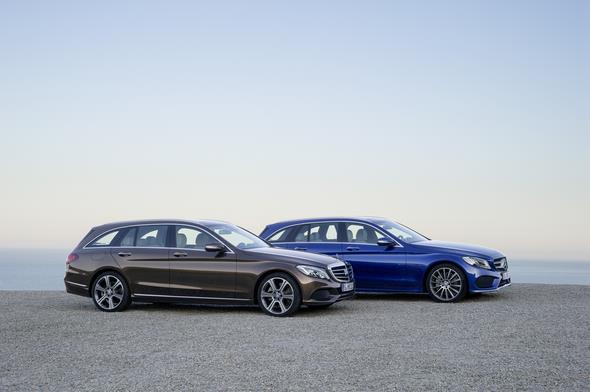
Vibrant infotainment experience
Like the Saloon, the new Estate offers a completely new multimedia generation with intuitive operation, featuring elaborate animations and visual effects which present all the functions in a clear and highly attractive manner.
The Estate is furthermore also equipped with the Frontbass system. This avant-garde acoustic systems uses the space within the cross-member and side member in the body structure as a resonance chamber for the subwoofers.
The result is a listening experience almost on a par with that enjoyed in a concert hall. A Burmester® surround sound system is optionally available.
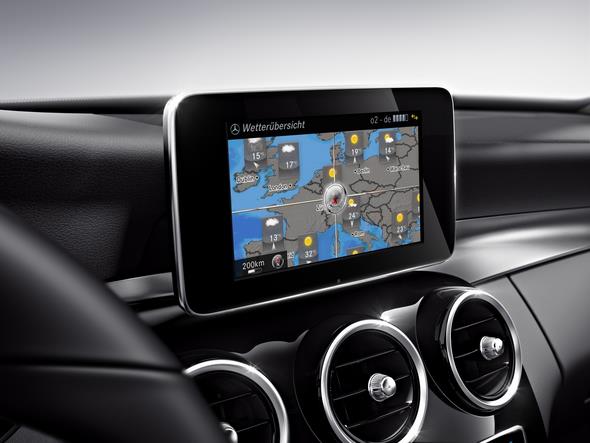
The navigation system presents its contents in interactive mode. Its features include an animated compass, a “Drive Show” with information for passengers similar to the on-screen presentations on board airliners and Google Maps displayed on the head unit.
COMAND Online is now also able to provide more accurate real-time information about the situation on the roads when it receives its traffic data via the internet by means of the “Live Traffic Information” service.
Internet and diverse data sources
A Bluetooth-compatible mobile phone with data option is all it takes to make even the Audio 20 system internet-capable. This enables the internet to be surfed without restrictions when the vehicle is stationary.
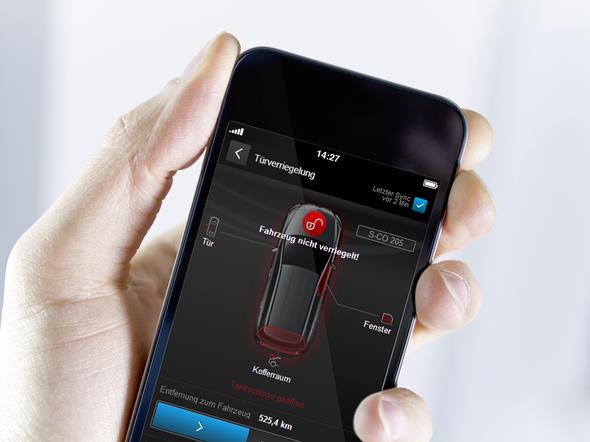
In conjunction with COMAND Online, Mercedes-Benz Apps such as Weather, GoogleTM Local Search with StreetView and Panoramio, destination/route download and Facebook can be used while on the move.
Audio and video playback is possible from various sources. For example, via Bluetooth®, from an Apple iPod® or iPhone®, from an SD card, USB stick or CD/DVD (with Audio 20 CD or higher and with COMAND Online).
COMAND Online with hotspot functionality
COMAND Online not only offers a larger display with a resolution of 960 x 540 pixels and a special bonded glass cover such as is familiar from consumer devices like the iPhone® or iPad.
It also enables digital TV/radio reception, for example, and offers fast hard-disc navigation, automatic tailback avoidance via up-to-date and accurate “Live Traffic Information”, an integrated WLAN hotspot functionality and the LINGUATRONIC voice-operated control system.
Telephony via Bluetooth® as standard
The standard Audio 20 USB system as well as Audio 20 CD and COMAND Online all offer basic telephony as standard, which links up a mobile phone to the vehicle via a standardised Bluetooth® interface.
Vehicle online with Mercedes connect me
Mercedes-Benz will introduce a new package of services in Europe under the name “Mercedes connect me” with the new C-Class Estate.
The “Mercedes connect me” services can be used via a KOM module with its own SIM card integrated into the vehicle. The available services include accident, maintenance and breakdown management, for example.
Likewise, customers can connect to their vehicle from anywhere and at any time via “Mercedes connect me“ and, among other things, retrieve the fill level of the tank or start, stop or programme the auxiliary heating system.

Under the microscope: body shell
Intelligent lightweight construction
Thanks to innovative solutions, the body shell of the new C-Class Estate weighs less, provides the basis for outstanding vehicle handling and best noise and vibration comfort with exceptional rigidity, and offers a high level of crash safety.
Lighter cars are more efficient. That is why Mercedes-Benz has substantially reduced the weight of the new C-Class Estate.
Thanks to intelligent and innovative lightweight construction, the aluminium-hybrid body shell as well as front wings, bonnet, liftgate, doors and roof panelling made of sheet aluminium weighs about 65 kilograms less that its comparable predecessor model.
This makes it the “lightweight-construction leader” in its segment.
Less weight pays dividends in multiple ways: fuel consumption drops by up to 20 per cent and at the same time it makes a lower centre of gravity possible, which results in noticeably sporty-agile vehicle handling.
Mercedes-Benz achieved this technological leap primarily through an entirely new design and the extensive use of aluminium, hot-formed steel parts and ultra-high-strength steels – an unusual combination in volume-production vehicles.
The proportion of these materials has therefore increased noticeably compared with the successful predecessor.
Previous model seriesnew C-Class
Aluminium (sheet metal and cast) 9% (4%) 49% (25%)
Hot-formed steel parts3% (4%) 8% (12%)
Ultra high-strength steels 3% (3%) 4% (6%)
Figures in percent of surface area (percentage of weight)
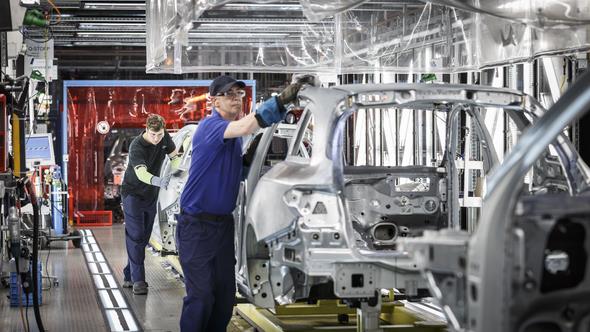
The body shell engineers achieved further benefits – both in terms of weight and as regards other important body characteristics – by means of an intelligent lightweight construction concept.
As part of this process, they have redesigned each detail optimally and not simply replaced steel with aluminium.
After all, the specification not only required a reduction in weight, but also called for a body shell which in many respects sets new challenging standards, with hitherto unprecedented performance in this segment – for instance the high rigidity at the load introduction points from the suspension to the body or in relation to the NVH (noise, vibration, harshness) characteristics. This is a major factor in optimising road noise.
New body shell concepts proved the most direct way of meeting these requirements. For instance, the designers exploited the greater design leeway offered by die-cast aluminium compared with steel.
The body consists, among other things, of eight large die-cast components. The same designers also managed to integrate and merge various elements into a single die-cast component, which with conventional design would have to be made up of several steel parts.
In this way a host of functions can be rendered in a single component and installation space put to optimum use. For instance, all shock absorbers at the front and rear of the vehicle are mounted on such rigid aluminium die-cast components.
The liftgate has an all-aluminium lightweight design. The die-cast inner component gives the liftgate outstanding strength and reduces the weight at the same time.
The design options of die-cast components allow favourable use of the installation space as well as the integration of reinforcements. The sheet metal panelling is welded by lasers.
Other design details include larger cross-sections as well as precisely calculated stabilising beads in the floor and bulkhead. High-strength adhesives are used extensively to firmly bond the parts, which in turn helps increase the rigidity of the body shell.
The body shell clearly exceeds the values for overall vehicle rigidity, which are traditionally outstanding for Mercedes-Benz, and set a new benchmark in this segment.
As a result, the ambitious goals regarding dynamic vehicle handling and noise level have even been exceeded.
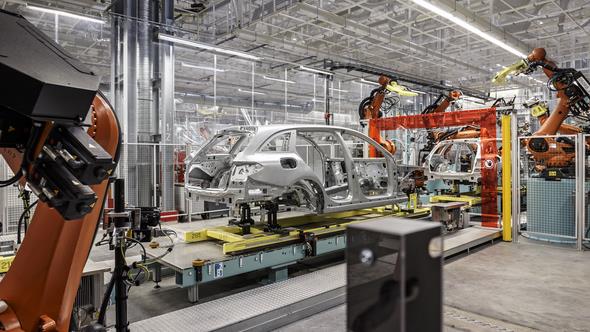
Safety takes precedence
In keeping with Mercedes-Benz traditions, the body shell is designed for exemplary crash safety. The Estate not only meets all current national and international laws, but also all rating requirements as well as the more stringent internal Mercedes-Benz safety requirements, which are based on what actually happens in real-life accidents.
A high-strength safety passenger cell forms the core of this concept. It consists primarily of high-strength and ultra-high-strength sheet steel and sheet metal with graduated wall thicknesses designed to withstand specific local stresses.
Many segments consist of hot-formed steels, which as the result of this production process become very hard and less deformable.
The high-strength passenger cell is surrounded by specifically calculated deformation zones which have been extensively field-tested.
Thanks to optimised dissipation paths and a combination of aluminium die-cast parts and ultra-high-strength materials, this set-up achieves outstanding crash test results (e.g. Euro NCAP) and guarantees maximum occupant safety.
The crash structure of the front end basically comprises three components:
- the front side members are bolted to the axle and engine mounts made of high-strength steel and extended towards the front and rear to specifically direct forces into the floor structure. In the case of a serious frontal collision, the subframe deforms in a defined manner in order to prevent intrusions into the passenger cell.
- The geometry of the front-end main side members has been further enhanced as the middle impact level to improve crash kinematics. The “laser welding” joining technique used here for the first time enabled, among other things, reinforcement parts to be fastened on both sides. They are crucial factors in improving the rigidity. Impact-absorbing elements in the side member extensions projecting forwards towards the front wheels help cushion the frontal impact early on.
- A third support structure above the front side members forms a second longitudinal plane to further increase deformation resistance in the event of a frontal collision.
A curved high-pressure hydroformed tube and aluminium cast consoles with additional struts, which have hitherto only been used in cabriolets, enclose the front module.
An additional strut made of high-strength steel between the damper dome and windscreen cross-member on the driver’s side distributes the load from forces in the upper side member plane and reduces steering and pedal intrusion in the footwell.
Reinforcement sections in the beltline area and at bumper level increase the rigidity and strength of the aluminium doors. The door handle areas are also protected by ring-shaped reinforcements.
The side wall structure is primarily reinforced with hot-formed ultra-high-strength materials.
This provides optimum occupant protection in the case of a side impact; the B-pillar design in particular makes an outstanding contribution in this respect. The front and rear end can be completely removed, making the vehicle easy to repair.
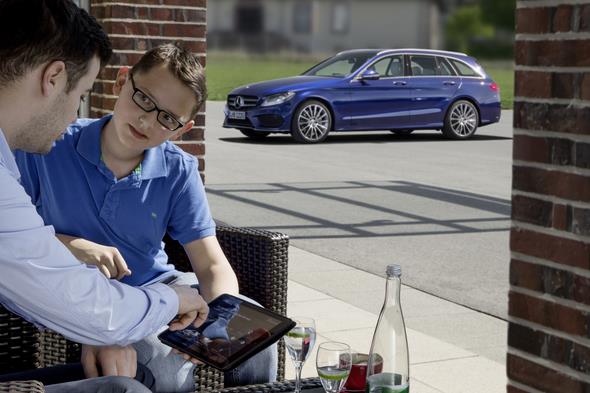
Under the microscope: Mercedes connect me
In online contact with the car
Mercedes-Benz will introduce a new package of services in Europe under the name “Mercedes connect me” with the new C-Class Estate.
Under the umbrella brand “Mercedes me” the Stuttgart-based premium automobile manufacturer bundles all existing and future service offers – easily accessible and available at all times on a digital internet platform.
The line-up can be accessed via a personalised Mercedes ID on the www.mercedes.me website.
“Mercedes me” also includes the new “Mercedes connect me” services. The “Mercedes connect me” services can be used via a KOM module with its own SIM card integrated into the vehicle.
The available services include accident, maintenance and breakdown management, among others.
Likewise, customers can connect to their vehicle from anywhere and at any time via “Mercedes connect me“ and, among other things, retrieve the fill level of the tank or start, stop or programme the auxiliary heating system.
Mercedes-Benz emergency call system
In an accident this service automatically connects the occupants with the Mercedes-Benz Emergency Call Centre and sends the position and the condition of the vehicle to the rescue operations centre.
It can then immediately dispatch a rescue vehicle. The system works automatically but can also be triggered manually.
The “Mercedes connect me” basic services comprise:
- Accident management – after the Mercedes-Benz emergency call it connects to the Customer Assistance Center to make it possible to request additional optional aid in dealing with the accident, e.g. a tow truck.
- Breakdown management – it provides technical assistance in the event of a breakdown. To this end it transmits the vehicle position and the condition of the vehicle to the Customer Assistance Center, which informs the Mercedes-Benz Service 24h. This allows the MercedesBenz Service 24h to provide fast and optimal help.
- Maintenance management – the vehicle detects and reports pending maintenance need and sends the necessary data to the service outlet as the basis for preparing a service quote.
- Telediagnosis – the vehicle detects the necessary replacement of diagnostics-capable wear parts and reports it to the dealer. The dealer contacts the customers to schedule a repair shop appointment. The previously transmitted data enables the repair shop to provide optimal assistance.
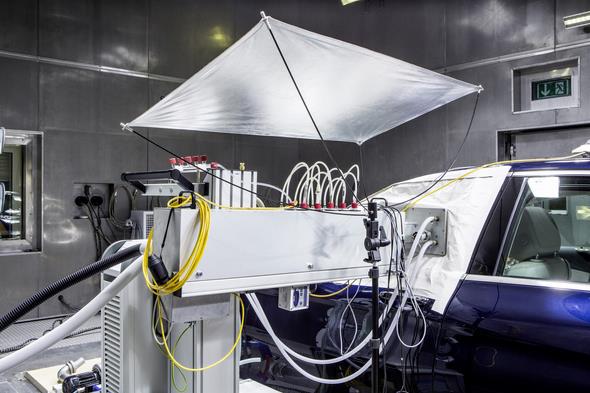
The “Live Traffic Information” service comprises:
- Real-time traffic data from TomTom in conjunction with COMAND Online – three-year term, can be extended after the end of the term for a fee.
The optional Remote Online services (can also be used with a smartphone via www.connect.mercedes.me) comprise:
- Vehicle position – allows determining the vehicle position, for example, if the vehicle was parked in an unfamiliar city. This makes it possible to conveniently find the vehicle with the help of a smartphone within a range of 1.5 kilometres.
- Vehicle position finding – enables pinpointing the current position of a moving vehicle via GPS. The driver has a display in the vehicle and can deactivate the service at any time with a toll-free call to the Customer Assistance Center.
- Geographic vehicle monitoring – displays where the vehicle is in an area previously defined on the map and informs the customer if the car leaves or enters this area. Just as in the case of vehicle position finding, the driver can deactivate the service at any time. (Expected availability from late 2014.)
- Remote door locking and unlocking – allows locking or closing the vehicle doors remotely, for example, if the driver forgot to lock the vehicle. (Expected availability from late 2014.)
- Remote access of vehicle status – vehicle data such as fuel gauge, state of charge, range and more can be accessed from home or while on the road.
- Programming of the auxiliary heater – if the vehicle is equipped with auxiliary heating, all functions such as starting, switching off or programming of the timer can be controlled online via a smartphone.
For vehicles with electric drive the Remote Online services are part of the standard specification and offer the additional functions “Programming of Charge Settings”, “Pre-Entry Climate Control” and “Route Planning”.
New C-Class awarded allergy label
Emphasis on clean air
Mercedes-Benz has been awarded the Seal of Quality of the European Centre for Allergy Research Foundation (ECARF) for its passenger cars. This makes Mercedes-Benz the only vehicle manufacturer to bear this seal.
The ECARF Seal of Quality is used by ECARF to designate products that have been scientifically tested and proven to be allergy-friendly.
Alongside comprehensive testing for inhaled and contact allergens, Mercedes-Benz has been testing the interior emissions of all its model series for 22 years now.
And a team of olfactory experts works to ensure that odours in Mercedes-Benz vehicles remain at a consistently pleasant level.
“We are delighted that the allergy-friendly nature of our Mercedes-Benz passenger cars has now been scientifically and independently recognised through the award of the ECARF Seal”, commented Dr Jörg Breuer, Director Certification, Regulatory Affairs & Environment at Daimler AG.
“Indeed, the constant improvement of air quality in the interior has for many years now been a key aspect of the development of components and materials for Mercedes-Benz vehicles.”
“In our estimation, Mercedes-Benz currently represents the benchmark in terms of allergen optimisation for vehicles”, according to Professor Dr Torsten Zuberbier, Director of the European Centre for Allergy Research Foundation (ECARF), which is based at the Charité university hospital in Berlin.
The new C-Class is the latest Mercedes-Benz model to have received the ECARF Seal of Quality. The conditions of certification have been met by all model series launched in recent years, from the A-Class to the S-Class.
The criteria behind the ECARF Seal are also included in the specifications book for all future Mercedes-Benz passenger car model series.
The emphasis on clean air applies for Mercedes-Benz in three particular areas: along with the avoidance of allergens, the concern is to reduce interior emissions and to keep odours at a consistently pleasant level. “We have been measuring the interior emissions of our vehicles since 1992 and have been able to make steady progress in reducing them”, according to Dr Breuer.
“We have a strict internal limit these days, which has to be met by all Mercedes-Benz passenger cars – by our compact vehicles and roadsters but equally by our large estates and SUV models.”
There are currently a dozen or more experts working in the development and materials technology area on the interior air quality of new models.
Over the course of the coming year, the team will also be moving into a new test centre at the Mercedes-Benz Technology Centre in Sindelfingen – a fact which also serves to emphasise the importance given to this topic.
Even in the early stages of the development of a vehicle, up to six years before it goes into production, the minimisation of interior emissions is a factor helping to define the materials concept.
As far back as 1996, Mercedes-Benz’s own internal standards set emission levels for materials used for components in the passenger compartment and boot.
Today designers and developers can make their choice from a database of around 8000 interior materials that have been approved by the specialist department.
Interior emissions: extensive testing of many components and all cars
Just before a new model goes into series production, its interior emissions are tested in a series of complex procedures. This type of analysis has been conducted by Mercedes-Benz since 1992.
Component assessment involves the testing of numerous parts from each equipment variant of a model series – door panels and seats as well as the roof liner and trim.
In order to ensure that a realistic impression is gained, the team do not use specially produced sample components but standard production components produced using the tools that will be subsequently used for series production.
The testing procedure prescribes adherence to the VDA 276 standard as laid down by the German Motor Industry Association – the components are stored and measured in a test chamber 1 m3 in size at a defined temperature, humidity level and air circulation rate. Air samples are then extracted and used to measure the quality and quantity of gaseous substances in the air.
The examination of the vehicle as a whole involves an even more complex process.
The necessary preparation of the vehicle alone, in other words the installation of the measuring equipment, takes the well-rehearsed team three quarters of an hour, while the measurements themselves last a full week.
The test chamber is lined with stainless steel in order to prevent it giving off emissions of its own.
Large radiant heaters are used to simulate the sun and heat up the interior of the vehicle, since for physical reasons emissions are greater under the influence of heat. The solar irradiance is measured by special devices called pyranometers.
Inside the vehicle, as many as ten sensors are used to record the temperature in various areas, for example on the top of the dashboard.
A rotating paddle stirs up the air inside the vehicle to ensure an even mix. Overall emissions within the vehicle are calculated with the help of a rack-mounted flame ionisation detector.
The rack projects into the vehicle interior over the opened window on the driver’s side, which has been made airtight and emission-neutral with the aid of aluminium foil.
If taking measurements according to test method FAT AK 26, for example, measuring can begin as soon as a temperature of 65 degrees Celsius has been reached at the level of the driver’s nose.
Samples of air are extracted from the interior and the air flow directed into a series of test tubes. The chemical composition of the evaporated substances is then analysed in the laboratory.
“We use different sampling techniques for the various categories of substance that we analyse”, explains Hartmut Kovacs, Design for Environment, Head of Interior Emissions at Mercedes-Benz. “All in all, we take more than 100 samples from each vehicle.” As well as the overall emissions, it is therefore also possible to measure the emissions of individual organic compounds.
The emissions experts also look at a vehicle’s propensity to fogging – in other words the creation of a film of condensable substances on a car’s windscreen: the measuring rack therefore also includes a cooled sheet of glass upon which these less volatile substances, if present, are deposited.
In addition to this static test, a further series of tests are used to evaluate emission activity in the interior of the vehicle while it is in use.
These tests take place with the engine running and the air-conditioning system switched on, with and without air recirculation.
A further touch involves the driver’s door being opened once during each measurement cycle to simulate the driver getting into the vehicle.
ECARF Seal: extensive allergen testing
“In our estimation, Mercedes-Benz currently represents the benchmark in terms of allergen optimisation for vehicles”, according to Professor Dr Torsten Zuberbier, Director of the European Centre for Allergy Research Foundation (ECARF), which is based at the Charité university hospital in Berlin.
In industrialised countries these days, allergic conditions are now the most common form of chronic illness.
In Germany, for example, around 30 percent of the population are affected. One in ten absences from work as a result of sickness is now attributable to an allergy.
But the pollen count is not the only problem to afflict motorists who suffer from allergies: emissions given off by the materials used in the interior or when contact surfaces are touched can also lead to a strong reaction, with symptoms such as swelling and inflammation of the nasal passage, hay fever or asthma.
But not in a Mercedes-Benz vehicle: numerous model series, from the A-Class to the S-Class and now also the C-Class, meet the criteria of the allergy label.
The conditions involved are extensive: numerous components from each equipment variant of a vehicle have to be tested for inhaled allergens, for example. Furthermore, the function of the pollen filter must be tested in both new and used condition.
And then there are tests with human “guinea pigs”. Driving tests, for example, were conducted with people suffering from severe asthma, with lung function tests providing information about the impact on the bronchial system.
In addition, all materials that might come in contact with the skin were dermatologically tested. So-called epicutaneous skin tests were undertaken with test subjects suffering from contact allergies in order to test the tolerance levels for known contact allergens such as chrome-nickel and various pigments.
This involved substances from the interior that were deemed to be potential allergens being applied with plasters to the skin for 72 hours and the reaction to them being evaluated after 48 and then 72 hours.
The air-conditioning filters also have to meet the stringent criteria of the ECARF Seal in both new and used condition: amongst other things the tests measure their retention efficiency with regard to dust and pollen.
The professional sniffers: tracking down pleasant smells
Ultimately responsible for ensuring that odour levels in Mercedes-Benz vehicles remain consistently pleasant is a team of olfactory experts.
Mercedes-Benz has carried out an odour test since 1992. The olfactory experts take a sample of every single material that is to be used inside a new vehicle.
They place this sample in a standard, odour-free preserving jar, which is then sealed and heated for two hours at 80 degrees Celsius.
This is the temperature that can be reached inside a car if it is left in the blazing sun. And it is a fact of physics that odours become stronger under the influence of heat. The testers than allow the jars to cool down to 60 degrees, ready for the “sniffing” to begin.
Each tester lifts the lid up slightly, smells the air inside the jar and writes down a mark for the strength and quality of the smell. The final result represents the mean value of all the marks.
The assessment scale corresponds to the German school grades system, i.e. from one to six. A grade-one odour is “imperceptible” (for example glass, metals, stones), while three indicates an “obvious and distinctive smell, but not unpleasant” and six is “unbearable”.
Everything in the grade range from one to three passes the test. Materials that fare worse cannot be used in the vehicle. It’s then up to the supplier to make improvements. If the material passes a re-test, that test result becomes mandatory.
In order to test the odour produced by the interaction of all the various materials, the experts quite literally stick their noses into the finished vehicle before it goes into series production.
Four of them jump in, close the doors and have a good sniff. The odour team also carry out an olfactometric test. For this, the interior of the vehicle – with all its doors and windows closed – is warmed up by large heaters.
Using a bag, the specialists take an odour sample of the ambient air inside the closed vehicle. This bag is then attached to an olfactometer, a special device for measuring smells, and diluted with pure, odourless air before being smelt by a group of test subjects.
New C-Class: Climate control system uses signals from space
A significant factor in the excellent air quality found in the interior of the new C-Class is the further developed climate control system.
The two-zone automatic climate control has separate settings for the left and right, THERMOTRONIC a further setting for the rear.
However, instead of channelling the air to the rear via an air duct as is customary, it has its own blower in the centre console. This lets rear-seat passengers set their own feel-good climate.
The THERMOTRONIC three-zone automatic climate control is optionally available, the only real such system in this segment. In addition to separate controls for the driver and front passenger, it provides the option of setting the temperature and air flow in the rear compartment.
It also offers a choice of three ventilation modes: Medium, Focus, Diffuse. In addition the system is equipped with a pollutant sensor that switches automatically to air recirculation mode – particularly useful, for example, when caught in a traffic tailback alongside trucks.
The new C-Class is the only vehicle in the segment to offer tunnel detection via satellite navigation.
On the basis of map information from the navigation system and the GPS location data, the system detects when the vehicle enters a tunnel.
It then automatically closes the air recirculation flap in order to prevent the exterior fume-filled air from entering the vehicle via the air vents. Once the vehicle has left the tunnel, the flap opens and fresh air can once again flow into the interior.
Another highlight for creating the feel-good atmosphere is the AIR-BALANCE package with active fragrancing, ionisation and even more efficient filtration compared with the standard model.
It was adopted from the S-Class, in which the AIR-BALANCE package only recently celebrated its world premiere.
The various fragrances available have been specifically developed for this purpose and, like the ionisation and filtration functions, tested by ECARF for their acceptability to allergy sufferers.
Ionisation is another component of the AIR-BALANCE package, with which the air from the air conditioning is conducted into the interior via the ioniser.
The ioniser generates oxygen ions by means of high voltage. The air ionised in this way can eliminate certain viruses, bacteria and spores.
At the same time the air can be freshened by an increased concentration of negatively charged oxygen ions. Both help to increase the well-being of passengers.
In tests undertaken with asthmatics, under the supervision of Professor Zuberbier, the test subjects reported a clear improvement in their well-being as a result of the ionisation process.

